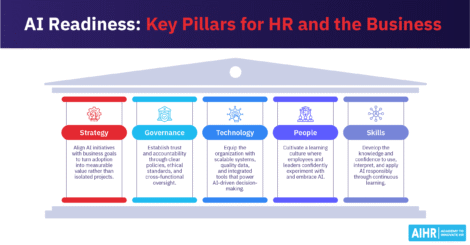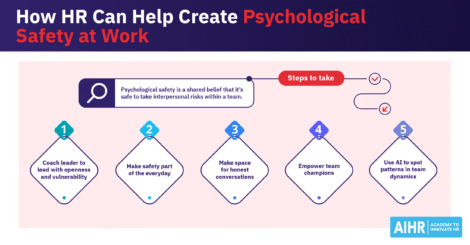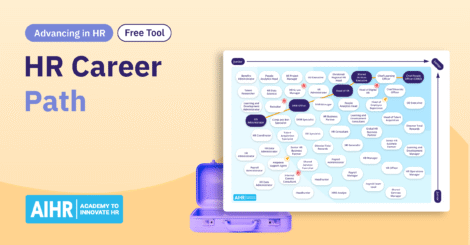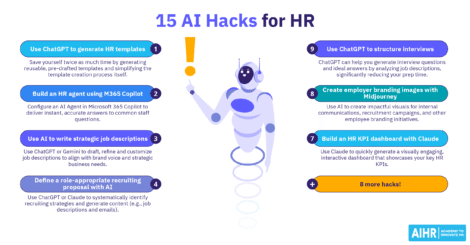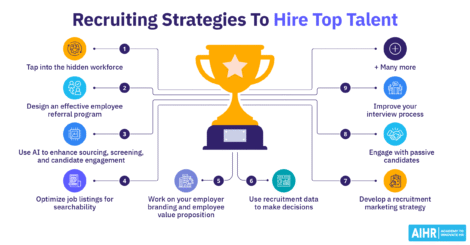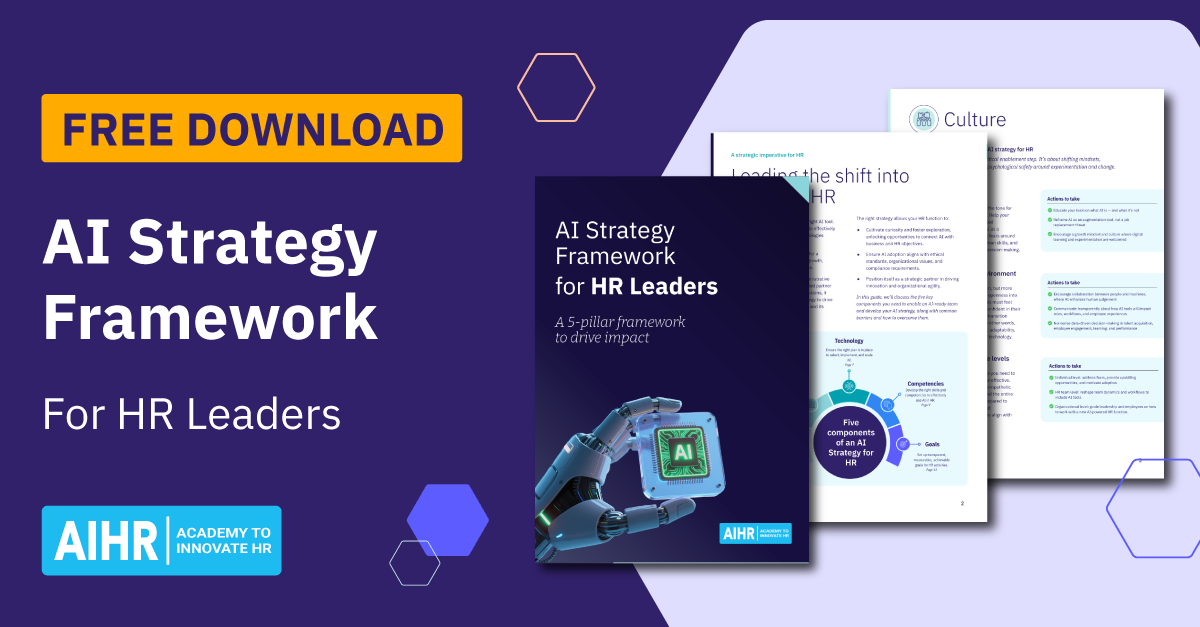It is no secret that HR strategy must align with the business needs. Our data from over 1,200 organizations shows that HR leaders are well aware of this need. HR leaders spend significant time aligning, cascading goals, building out scorecards, and defining the relevant KPIs to show impact.
But here’s where things often break down. Once that translation happens, the business doesn’t always recognize how HR’s strategic focus connects back to its goals. Even though HR aligns strategies, the business, at times, remains unaware of how HR priority moves the needle on business objectives.
This article discusses the importance of aligning HR and business strategies, what happens when there is a disconnect, and a practical approach to ensuring seamless alignment.
Contents
Why is there a disconnect between the business and HR?
Why it’s important to align HR strategy with business strategy
What happens when HR and business strategies don’t align?
How to align HR and business strategy with intent
Why is there a disconnect between the business and HR?
For years, we at AIHR have emphasized that HR professionals must speak the language of business and possess strong business acumen. While this remains crucial, it’s no longer enough. HR leaders must go further to demonstrate how HR contributes tangible value to the company.
Beyond understanding the business, HR practitioners must also educate business leaders on the “why” and “how” behind specific HR activities, helping them see how these activities impact business goals. More importantly, business leaders often are not able to connect HR activities to the original business objective.
Take a typical example: An organization pursuing rapid growth through acquisitions as part of its business strategy. From an HR perspective, this strategy calls for investments in change management, culture integration, and capability building.
However, if these connections aren’t made explicit as to how these initiatives advance the business objective, business leaders unfamiliar with HR practices may struggle to see the value. Their unspoken question becomes: How does this HR focus help us achieve our business growth targets?
This disconnect isn’t unique to HR.
Other functions, like Finance and Marketing, have faced similar challenges. The difference is that most business leaders have, over time, built a working knowledge of financial and marketing principles. When Finance presents a cash flow management plan, leaders typically understand that cash flow is essential to fund operations and manage risk. When Marketing positions their brand plan, most business leaders realize the importance of investing in the brand.
However, HR does not always enjoy the same level of understanding. The reason for this is that very few leaders know the science that underpins some HR practices, so they rely on personal opinions and previous experiences to inform their views.
We discussed building a business-first HR strategy with Avi Kohli, the founder of intalent.ai, agentic AI for recruitment. Watch the full interview below:
6 reasons why HR and business strategy don’t align
Misalignment between HR and business strategy can occur at several points due to these common pitfalls:
- Late or little involvement in strategic planning: HR is often brought in after key decisions have been made, limiting the function’s ability to shape direction and align people strategies with business priorities.
- Weak link between business goals and HR initiatives: Business objectives aren’t always translated into focused, actionable HR programs. This disconnect reduces impact and makes it harder to demonstrate value.
- Inconsistent strategic communication: HR’s contributions are not communicated consistently or strategically, leaving business leaders unclear on the function’s role in driving outcomes.
- Failure to reinforce impact: We don’t regularly highlight or celebrate how HR efforts contribute to business success, which weakens buy-in and momentum.
- Underutilization of data: HR often misses the opportunity to use data and evidence to make a compelling case for its strategies, investments, and results.
- Insufficient stakeholder education: Business leaders may not fully understand HR’s strategic role or how it enables execution, leading to misalignment and underappreciation of the function.
Fortunately, these pitfalls are avoidable, but they require an intentional and structured approach.
Why it’s important to align HR strategy with business strategy
There is no shortage of evidence showing that organizations with well-aligned HR and business strategies consistently outperform those without them.
Research has shown that high-performing HR systems, built on practices like strategic workforce planning, targeted skill development, and performance-based rewards, are linked to stronger profitability, productivity, and shareholder value.
But the benefits go beyond financials. When HR is aligned with business strategy, it drives higher levels of employee engagement and commitment, which have been linked to improvements in customer satisfaction and market share.
Furthermore, it also solves the challenges that HR experiences in terms of being seen as a strategic partner. By explicitly being tied to business strategy, HR is able to demonstrate its impact clearly, thereby also solving misperceptions about the value and relevance of the function.
As an HR person, I was expected to really proactively think about, hey, this is what my business is going through. Is there an HR team or an HR thread or an enabler to this challenge that they are facing, or what they are trying to do with their business? What can I do?

There is a big risk of HR strategy being decided and shaped within the HR team, with HR agendas in mind and HR metrics in mind, which could be a lot of vanity metrics at times versus a real impact on the business.

What happens when HR and business strategies don’t align?
The implications for the HR strategy not being aligned with the business strategy are significant. Even though the symptoms start small, they quickly build and create lasting damage.
The first disconnect starts with seeing misallocated resources, with HR investing time, budget, and effort into resources that the business does not see the value of. HR might launch a new leadership development program or roll out a sophisticated wellbeing platform, but these initiatives will fail without a clear link to the business’s growth priorities.
This leads to a questioning of HR’s purpose. Business leaders begin to ask: “What is HR solving for?” If they can’t draw a straight line from HR initiatives to business outcomes, like increased sales effectiveness, faster onboarding, or stronger innovation pipelines, HR’s credibility starts to erode.
Once that happens, the financial consequences follow. Budget allocations shrink, not because HR is less important, but because it’s perceived as not essential to business success. When budgets are tight, investment flows toward functions that enable growth, market share, or efficiency, and HR gets left behind.
This reinforces the perception of HR as a cost center rather than a value creator. In some organizations, HR is quietly sidelined, centralized into shared services, or outsourced entirely. The belief becomes: “We just need HR to process the basics. Strategy is someone else’s job.”
How to align HR and business strategy with intent
No matter which business strategy framework your organization uses, HR leaders must follow five essential steps to ensure their HR strategy is business-relevant and contributes real value:
Step 1: Understand
Before anything can be translated or aligned, HR must first understand the business strategy in depth. This means grasping not just the high-level goals but also the drivers of success, the value creation levers, and the internal and external factors influencing the business.
Without this foundational understanding, HR risks misalignment from the start.
Ideally, HR is a key contributor to the business strategy process, leading to HR already having the strategic context. However, if this is not the case, HR needs to spend time understanding the “why” behind the strategy.
Litmus test: Can you explain the business strategy in plain language, as if you were the CEO?
In this step, HR can demonstrate that they:
- Know the organization’s strategic goals and why they matter now
- Can identify the value drivers (e.g., growth, efficiency, innovation, market entry)
- Understand what success looks like in business, not just in HR terms
- Can articulate the competitive landscape, risks, and core challenges.
Step 2: Translate
Once HR is clear on the business strategy, they must translate it into a meaningful people agenda.
A good approach here is for HR to craft so-called contribution statements aligned with each business goal. For example, if the business goal is to solve declining client satisfaction, the contribution statement can be phrased as follows:
For HR to help solve the business problem of declining client satisfaction, HR needs to contribute:
- A workforce with the right skills
- A culture that promotes client-centricity
- By implementing an incentive program to reward client-centric behaviors.
This translation explicitly makes the business case for HR’s role and helps shift the conversation from HR activities to the contribution that HR wants to make related to the business objective.
Litmus test: Can you clearly state what HR must contribute for the business to succeed, and would business leaders agree?
Here, HR can demonstrate that they:
- Have clear written HR contribution statements linked to business priorities.
- Ensured that each contribution statement answers the following: How does this help the business achieve its goal?
- Have aligned with business stakeholders to agree on what success looks like.

Step 3: Align
With contribution statements in hand, HR must align its resources to the prioritized contributions. This means breaking down these contributions further into key focus areas, specific initiatives, measurable objectives, and the resources required to deliver.
It also requires strategic choices: Where will HR invest its time and energy? What will be prioritized? What will be deferred or deprioritized?
Alignment is about ensuring that while HR contributions are aligned to business, so too are the internal HR resources required to deliver. This could also imply that HR needs to stop doing some of the current activities it might have been busy with to ensure the capacity to drive strategic execution.
This step is not about saying yes but rather about being clear on what HR will and won’t do.
Litmus test: Can every HR activity and initiative be traced back to a business-relevant contribution?
HR should be able to demonstrate that they:
- Made intentional choices about what HR will focus on and what it won’t
- Have clear objectives that are specific, measurable, and logically derived from the contribution statements
- Created alignment across HR sub-functions (e.g., Talent, L&D, Rewards).
Step 4: Connect
The next step is to connect HR strategy back to the business in a way that makes sense to non-HR audiences. When sharing the HR strategy, frame it as a direct response to business needs:
“Because the business wants to achieve X, HR will focus on Y, which delivers Z, enabling the organization to reach X.”
This deliberate looped narrative helps stakeholders see how HR contributes to the broader picture and reinforces shared ownership of results.
Litmus test: Can business leaders repeat the HR strategy to you and link it to their goals?
In this step, HR can demonstrate that:
- Leaders outside HR can articulate how HR is helping achieve strategic outcomes
- HR updates are part of regular business reviews.
But it’s really the accountability of the business leaders, the business managers, who drive that culture. So, any HR strategy has to be co-owned and co-sponsored by business leaders, hand in hand.

Step 5: Reiterate
The best-aligned strategies lose momentum when they aren’t reinforced. That’s why the final step is reiterating and continuously reinforcing the connection between HR strategy and business priorities. This involves regularly checking alignment, updating stakeholders, and adjusting the course when needed.
Reiteration isn’t repetition for the sake of repetition. It reminds stakeholders why HR is focused on specific priorities and keeps the people strategy at the top of the organization’s mind.
It also creates a rhythm of accountability. Returning to the original business objectives and showing progress, HR builds credibility.
Litmus test: Are you consistently reinforcing the HR and business strategy connection over time?
At this stage, HR can demonstrate that the:
- HR strategy is revisited and refined as business needs evolve
- Progress updates explicitly tie HR results back to business goals
- Business leaders hear the same message consistently across forums.
Final words
As business demands more from HR teams, being misaligned between HR and business strategy should no longer be tolerated. By adopting a different approach, HR can ensure the relevance of the strategy and improve the perception of value that we contribute as people professionals.










